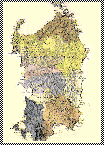

The original paperback is printed by 2D Editrice Mediterranea, Sassari (Italy)
HTML version developed by :
Luigi.Filippini
Scientific Visualization Group
CRS4
The first man to settle in Gallura and Northern Sardinia probably came from Italian mainland and, in particular, from Etruria. Those who populated the central region of the island arrived, it seems, from the Iberian Peninsula by way of the Balearic Islands. Those who founded their settlements around the gulf of Cagliari were in all likelihood Africans. Hence, it can be said that in Sardinia there never was one single people but really several peoples.
As time passed, the Sardinian peoples became united in language and customs yet remained divided politically into various smaller tribal states. Sometime they were banded together, while at others they were at war with one other.
Tribes lived in villages made up round thatched stone huts, similar to the present day pinnette of shepherds.
Prehistoric arrowheads (III millennium B.C.) and sculpture of the the Mediterranean Mother Goddess may be found in the Archeological Museum of Cagliari. In the Archeological Museum of Sassari are some ceramics from the Copper or Aneolithic Age (2600 B.C.).
From about 1500 B.C. onwards the villages were built at the foot of a mighty truncated cone fortress (often reinforced and enlarged with embattled towers) called nuraghe.
A nuragic village may be found in Barumini (Cagliari).
The boundaries of tribal territories were guarded by smaller lookout nuraghi erected on strategic hills commanding a view of the enemy. Today some 7000 nuraghi dot the sardinian landscape.
With the local chieftains' consent the more common ports of call were those later named as : Caralis, Nora, Bithia, Sulcis, Tharros, Bosa, Torres and Olbia. They soon became important markets and after a time real towns inhabited by Phoenicians families who traded on the open sea and with the Nuragic Sardinians inland.
A bronze statuette of a Nuragic chieftain and some Phoenicians handicraft are in the Archeological Museum of Cagliari.
In 509 B.C., in view of the Phoenician expansion inland becoming ever more menacing and penetrating, the native Sardinians attacked the coastal cities held by the enemy who, in order to defend themselves, called upon Carthage for help. The Carthaginians, after a number of military campaigns, overcame the Sardinians and conquered the whole island apart from the most mountainous region, later referred to as Barbaria or Barbagia.
For 271 years, the splendid Carthaginian or Punic civilization flourished alongside the fascinating local nuragic culture. A Nuragic massive head of warrior and a Carthaginian goddess are in the Archeological Museum of Cagliari.
In 238 B.C the Carthaginians, defeated by the Romans in the first Punic War, surrendered Sardinia which became a province of Rome.
The Romans enlarged and embellished the coastal cities and with their armies even penetrated the Barbagia region, thereby bringing down the Nuragic civilization.
In 456 A.D., when the Roman Empire was sinking fast, the Vandals of Africa, on their return from a raid in Latium on the mainland, occupied Caralis along with the other coastal cities of Sardinia. In 534 the Vandals were defeated at Tricamari, a place some 30 Km form Carthage, by the troops of the Eastern Emperor Justinian and Sardinia thus became Byzantine. The island was divided into districts called mereie, governed by a judex residing in Caralis (Cagliari) and garrisoned by an army stationed in Forum Traiani (nowadays Fordongianus) under the command of a dux.
Along with the Byzantines and the Eastern monasticism of the followers of St. Basil, Christianity spread throughout the island, except in the Barbagia regions. Here, towards the end of the sixth century, a short-lived independent domain reestablished itself, with Sardinian-heathen lay and religious traditions, one of its kings being Ospitone.
From 640 to 732 the Arabs occupied North Africa, Spain and part of France. In 827 they began their occupation of Sicily. Sardinia remained isolated and was forced to defend herself; thus, the judex provinciae assumed overall command with civil and military powers.
The continual raids and attacks by the Islamized Berbers on the Sardinian shores began in 710 and grew ever more ruinous with time. One by one the coastal towns and cities were abandoned by their inhabitants. The judex provinciae, in order to afford a better defence of the island, assigned his civil and military powers to his four lieutenants in the mereie of Cagliari, Torres or Logudoro, Arborea and Gallura. Around 900, the lieutenants gained their independence, in turn becoming judices (in Sardinian judikes means king) of their own logu or state.
Each one of these four Sardinian states called giudicati constituted a sovereign kingdom, not patrimonial but independent since it was not the property of the monarch. But they were at the same time democratic since all the most important issues of national interest were not for the king (or giudice) himself to decide but were a matter for the representative of the people gathered in assembly called corona de logu.
Each kingdom manned its own fortified boundaries to protect its own political and trading affairs, its own parliament, own laws (cartas de logu), own national languages, own chancelleries, own state emblems and symbols, etc. The kingdom or giudicato of Cagliari was politically pro-Genoese. It was brought to an end in 1258 when its capital, S. Igia, was stormed and destroyed by an alliance of Sardinian-Pisan forces. The territory then became a colony of Pisa. The kingdom or giudicato of Torres, too, was pro-Genoese and came to an end in 1259, on the death of the giudicessa Adelasia. The territory was divided up between the Doria family of Genoa and the Bas-Serra family of Arborea, while the city of Sassari became an autonomous city-republic.
The kingdom or giudicato of Gallura ended in the year 1288, when the last giudice Nino Visconti a friend of Dante's, was driven out by the Pisans who occupied the territory. The kingdom or giudicato of Arborea was almost always under the political and cultural influence of the powerful marine republic of Pisa. It lasted some 520 years, with Oristano as its capital.
In 1297, Pope Boniface VIII in order to settle diplomatically the War of the Vespers, which broke out in 1282 between the Angevins and Aragonese over the possession of Sicily, established motu proprio a hypothetical regnum Sardiniae et Corsicae. The Pope offered it to the Catalan Jaume II the Just, king of the Crown of Aragon (a confederation made up of the kingdoms of Aragon and Valencia, plus the peasants of Catalonia), promising him support should he wish to conquer Pisan Sardinia in exchange for Sicily. In 1323 Jaume II of Aragon formed an alliance with the kings of Arborea and, following a military campaign which lasted a year or so, occupied the Pisa territories of Cagliari and Gallura along with the city of Sassari, naming them kingdom of Sardinia and Corsica.
In 1353, for reasons of state survival, war broke out between the kingdom of Arborea and the kingdom of Sardinia and Corsica part of the Crown of Aragon. In 1354 the Aragonese seized Alghero and reshaped it into an entirely Catalan city, which still today displays its Iberian origins. In 1353 Pere IV of Aragon, called the Cerimonious, granted legislative autonomy (a parliament) to the kingdom of Sardinia and Corsica which was followed in due course by self-government (Viceroy) and judicial independence (Royal Hearing).
From 1365 to 1409 the kings or giudici of Arborea Mariano IV, Ugone III, Mariano V (assisted by his mother Eleonora, the famous giudicessa regent) and Guglielmo III (French grandson of Eleonora) succeeded in occupying very nearly all Sardinia except Castel of Cagliari (today Cagliari) and Alghero. In 1409 Marti the Younger, king of Sicily ad heir to Aragon, defeated the giudicale Sardinians at Sanluri and conquered once and for all the entire land. Shortly afterwards he died in Cagliari of malaria, without issue, and consequently the Crown of Aragon passed into the hands of the Castilians Trastamara, and in particular Ferran I of Antequera and his descendants, with the Compromise of Caspe in 1412.
The tomb of Marti the Younger is in Cagliari Cathedral.
In 1479, as a result of the personal union of Ferran II of Aragon and Isabel of Castile (the so-called Catholic king and queen), married ten years earlier, was born the Crown of Spain. Even the kingdom of Sardinia (which in the new title was separated from Corsica since that island never was conquered) became Spanish, with the state symbol that of the Four Moors. Following the failure of the military ventures against the Musulmen of Tunis (1535) and Algiers (1541) Carlos V of Spain, in order to defend his Mediterranean territories from the pirate raids by the African Berbers, fortified the Sardinian shores with a system of coastal lookout towers. The kingdom of Sardinia remained Iberian for approximately four hundred years, from 1323 to 1720, assimilating a number of the Spanish traditions, customs, linguistic expressions and lifestyles, nowadays vividly portrayed in the folklore parades of S. Efisio in Cagliari (May lst), by the Cavalcade in Sassari (last but one Sunday in May) and by the Redeemer in Nuoro (August 28th).
In 1708 as a conseguence of the Spanish War of Succession, the rule of theKingdom of Sardinia passed into the hands of the Austrians who landed on the island.
In 1717 cardinal Alberoni, minister of Felipe V of Spain, reoccupied Sardinia.
In 1718 with the traty of London, the kingdom of Sardinia was handed over to the Dukes of Savoy, prices of Piedmont, who rendered it perfect from imperfect attributing it the summa potestas that is the authority to stipulate international treaties. The kingdom was then italianized.
In 1799, as a consequence of the Napoleonic wars in Italy, the dukes of Savoy left Turin and took refuge in Cagliari for some fifteen years. The tomb of Carlo Emanuele of Savoy is in the cript of Cagliari Cathedral.
In 1847 the sardinian spontaneously renounced their state autonomy and formed a fusion with Piedmont in order to have a single parliament. a single magistracy and a single government in Turin. The throne of the kingdom of Sardinia is in the Royal Palace in Turin.
In 1848 the Wars of indipendence broke out for the Unification of Italy and were led by the kings of Sardinia for thirteen years.
In 1861 the kingdom of Sardinia was transformed into the Italian state founded.
In 1946 by popular referendum Italy became a Republic. Sardinia, administered since 1948 by special statute, is today on of the twenty Italian regions, with 1,628,690 inhabitants spread out over the provinces of Cagliari, Sassari, Oristano and Nuoro, retracing more or less the territories of the four ancient and glourios giudicali states.
More informations and pointers to Web resources relevant to Roman art and archaeology may be found in the the ROMARCH homepage at the University of Michigan, a crossroads for the art and archaeology of Italy and the provinces of Rome, ca. 1000 B.C.-A.D. 600.